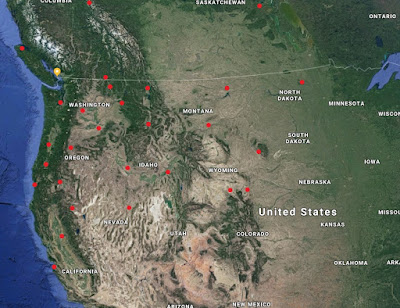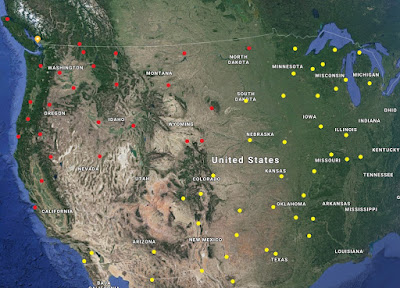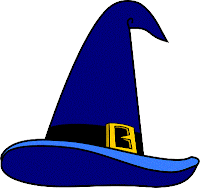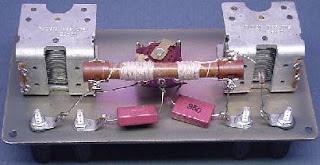Author Archive
 Hunting For NDBs In CLE246
Hunting For NDBs In CLE246
 |
| ZSJ - 258 kHz Sandy Lake, ON : source |
This coming weekend will see another monthly CLE challenge. This time the hunting grounds will be split: 240.0 - 259.9 kHz and 420.0 - 439.9 kHz.
For those unfamiliar with this monthly activity, a 'CLE' is a 'Co-ordinated Listening Event', as NDB DXers around the world focus their listening time on one small slice of the NDB spectrum.
If you've been meaning to participate in CLE, then maybe this weekend is a fine time to try! Lately, we've had a lot of first time submissions so you won't be alone!
As well, if you're trying to learn CW, copying NDBs is perfect practice as the identifier speed is generally slow and the letters are repeated again every few seconds!
A nice challenge in this one is to hear ZSJ - 258 kHz. 'ZSJ' is located at Sandy Lake, in northwest Ontario.
'ZSJ' runs 500W into a 150' vertical and is well-heard throughout North America. It has been reported in Hawaii and in Europe. Listen for its upper-sideband CW identifier (with your receiver in the CW mode) on 258.404 kHz.
At this time of the season, summer lightning storms may provide additional listening challenges but maybe we will get lucky. Propagation can often be as good as mid-winter if the lightning cooperates.
When tuning for NDBs, put your receiver in the CW mode and listen for the NDB's CW identifier, repeated every few seconds. Listen for U.S. NDB identifiers approximately 1 kHz higher or lower than the published transmitted frequency since these beacons are modulated with a 1020 Hz tone approximately.
For example, 'AA' near Fargo, ND, transmits on 365 kHz and its upper sideband CW identifier is tuned at 366.025 kHz while its lower sideband CW ident can be tuned at 363.946 kHz. Its USB tone is actually 1025 Hz while its LSB tone is 1054 Hz.
Often, one sideband will be much stronger than the other so if you don't hear the first one, try listening on the other sideband.
Canadian NDBs normally have an USB tone only, usually very close to 400 Hz. They also have a long dash (keydown) following the CW identifier.
All NDBs heard in North America will be listed in the RNA database (updated daily) while those heard in Europe may be found in the REU database. Beacons heard outside of these regions will be found in the RWW database.
From CLE organizer Brian Keyte, G3SIA, comes the details:
Hello all,
These are the final details for our 246th co-ordinated listening event
this weekend. We'll be listening in two contrasting frequency ranges.
First timer logs too? Yes, please!
Days: Friday 26 July to Monday 29 July
Times: Start and end at midday, your LOCAL TIME
Range: 240.0 - 259.9 kHz plus 420.0 - 439.9 kHz
(BOTH ranges are for ALL listeners)
Please log NDBs that you can positively identify in the ranges, plus
any UNIDs that you come across there.
The lower frequency range will be really hard for most listeners in
Europe, the higher range not at all easy for most others.
Send your final CLE log to [email protected] if possible as a plain text
email and not in an attachment.
Show CLE246 and FINAL at the start of its title to help us find your log.
Show on EVERY LINE of your log:
# The Date (e.g. 2019-07-26, etc.) or day (e.g. 26)
# UTC (the day changes at 00:00 UTC).
# kHz - the beacon's nominal published frequency (if you know it).
# The Call Ident.
Please show those main items first on each line, BEFORE any optional
details (Location, Offsets, Cycle time, Distance, etc.)
If you send interim logs, do make sure that you also send a 'FINAL' log
containing all your loggings. As always, do make your log useful and
interesting to everyone by including your own location and brief details
of the receiver, aerial(s) and any recording equipment that you used.
We will send the usual 'Any More Logs?' email at about 19:00 UTC on
Tuesday so that you can check that your Final log has been found OK.
Do make sure that your log has arrived on the List at the very latest
by 08:00 UTC on Wednesday 31 July. Joachim and I hope to complete
making the combined results within a day or two.
To help you with your search you can find lists and maps showing the
target NDBs for your part of the World at http://www.ndblist.info/cle.htm
Select the CLE SEEKLIST link there.
Good listening
Brian
--------------------------------------------------------------------
From: Brian Keyte G3SIA ndbcle'at'gmail.com
Location: Surrey, SE England (CLE coordinator)
--------------------------------------------------------------------
(Reminder: You could use any one remote receiver for your loggings,
stating its location and owner - with their permission if required.
A remote listener may NOT also use another receiver, whether local
or remote, to obtain further loggings for the same CLE).
These listening events serve several purposes. They:
The NDB List Group is a great place to learn more about the 'Art of NDB DXing' or to meet other listeners in your region. There is a lot of good information available there and new members are always very welcome. As well, you can follow the results of other CLE participants from night to night as propagation is always an active topic of discussion.
You need not be an NDB List member to participate in the CLEs and all reports, no matter how small, are of much value to the organizers.
Remember - 'First-time' logs are always VERY welcome!
Reports may be sent to the NDB List Group or e-mailed to CLE co-ordinator, Brian Keyte (G3SIA), whose address appears above. If you are a member of the group, all final results will also be e-mailed and posted there.
Please ... give the CLE a try ... then let us know what NDB's can be heard from your location! Your report can then be added to the worldwide database to help keep it up-to-date.
Have fun and good hunting!
- determine, worldwide, which beacons are actually in service and on-the-air so the online database can be kept up-to-date
- determine, worldwide, which beacons are out-of-service or have gone silent since the last CLE covering this range
- will indicate the state of propagation conditions at the various participant locations
- will give you an indication of how well your LF/MF receiving system is working
- give participants a fun yet challenging activity to keep their listening skills honed
The NDB List Group is a great place to learn more about the 'Art of NDB DXing' or to meet other listeners in your region. There is a lot of good information available there and new members are always very welcome. As well, you can follow the results of other CLE participants from night to night as propagation is always an active topic of discussion.
You need not be an NDB List member to participate in the CLEs and all reports, no matter how small, are of much value to the organizers.
Remember - 'First-time' logs are always VERY welcome!
Reports may be sent to the NDB List Group or e-mailed to CLE co-ordinator, Brian Keyte (G3SIA), whose address appears above. If you are a member of the group, all final results will also be e-mailed and posted there.
Please ... give the CLE a try ... then let us know what NDB's can be heard from your location! Your report can then be added to the worldwide database to help keep it up-to-date.
Have fun and good hunting!
 A Long Listen On 1240 KHz
A Long Listen On 1240 KHz
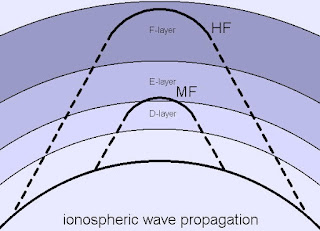 |
| Ionosphere: source |
One of the Broadcast Band’s (BCB) six ‘graveyard’ frequencies is 1240 KHz.
These frequencies (1230, 1240, 1340, 1400, 1450 and 1490 KHz) are assigned to smaller stations running non-directional antennas and up to 1000 watts of power. In North America, there are typically about 150 stations assigned to each frequency.
The origin of this spooky name is often a source of debate. Some suggest that it comes from the cacophony of strange howls and sounds that can be heard on these frequencies at night, as multiple fading signals fight it out to be heard, while others relate it to the similarity of the jam-packed headstones in a typical graveyard. Whatever the true reason, it's a fascinating part of the BCB to explore.
Most BCB DXers enjoy the challenge of tackling the graveyard frequencies as they're often so busy. New stations will fade in for a brief period only to be replaced by a totally different one a few moments later ... and then a different one soon after. It gets even better if the fade-ups coincide with a local ad or a ‘top-of-hour’ ID, putting a new catch in the log!
Several days ago I reactivated my 10’ x 20’ loop and Wellbrook ALA100N preamp, that I use for NDB and BCB DXing, by adding a new buried coax line from the shack.
I had previously re-appropriated the loop’s coax for a nearby HF wire antenna and had been without the loop all winter.
After BCB DXer Mike Cherry (VE7SKA) on Salt Spring Island, the next island to the west of me, described some of the European action that he had experienced last winter, I am determined to not miss out during the next winter's BCB DX season!
 |
| 10' x 20' Loop & Wellbrook ALA100N Preamp |
Once getting the loop powered-up in mid-afternoon, I decided to give it a test by making a ‘deep-search’ on 1240 KHz.
At 1500 hours local time, I wasn’t hearing any audio on 1240 but a weak carrier could be detected audibly. Using my Perseus SDR’s waterfall in its narrowest possible window, produces an extremely narrow passband, effectively increasing the sensitivity by a huge factor. This allows the waterfall to display weak signals that are presently being propagated to my location but far too weak to be heard by ear. I’m estimating that in this narrow bandwidth, it can dig about 30 dB or more into the noise, but there is a price to be paid for this extra gain .... time!
If you're used to watching your receiver’s waterfall scroll along quickly, this mode is just the opposite. It moves in very slow increments, allowing the weaker signals to build up enough to be visible before taking the next deep look. The screen capture shown below is a result of a three-hour listening period, from 1500-1800 hours local time. The entire waterfall is 25 Hz wide, with each tick representing 1Hz.
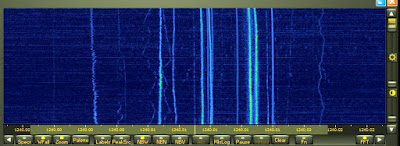 |
| 3-Hour Daylight Deep Search |
Although no signals were clearly audible during this period, my deep-search revealed the carriers of ~28 different stations being received here in south-west British Columbia ... in the middle of a summer afternoon! It’s interesting to note that few of these signals are 100% stable and several can be seen really struggling to maintain their exact assigned frequency. In this highly narrow bandwidth view, even the worst drift amounts to no more than a Hertz, well within the required tolerance of +/- 20Hz.
Using the always-reliable MWLIST, the locations of the most likely candidates for these 28 signals are plotted below. These are the 28 nearest stations and with my loop pointing east, a definite east / south-east flavour is evident.
At mid afternoon, one might expect to see only groundwave-propagated signals on the broadcast band. Midday groundwave on the broadcast band can easily travel a few hundred kilometers, gradually growing weaker over the longer paths. Perhaps all of these signals are arriving via this mode as they are at least 20-30dB into the noise. I initially thought that some of the further-out signals were being reflected from a strong daytime D-layer, although most of the energy would be absorbed. Further reading shows detectable groundwave up to 1200km is possible which coincides nicely with the distances observed. Most likely what I'm seeing is a combination of extended groundwave and D-layer refraction on the furthest signals.
The second screen capture shows the same frequency for another three hours, starting about an hour before local sunset. Some of the weaker signals seen earlier now begin to grow in strength as the D-later absorption starts to decay and reveal the higher E-layer. By the end of the third hour, an additional 41 stations have appeared for a total of 69 carriers cantered on 1240 KHz. (note that my Perseus calibration is off by a few Hz)
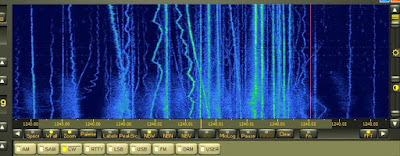 |
| 3-Hour Sunset Deep Search |
The next 41 closest stations are now plotted below in yellow, showing the most likely source of these signals. The distances illustrated are in-line with single and double-hop E-layer or possibly lower F-layer refraction.
This view shows the directional pattern of the front of the loop while pointing east, with its very broad circular lobe. In this direction, the narrow null is only seen along the coast.
It will be interesting to do a mid-winter follow-up on 1240 and compare the present summer propagation to the much better winter conditions. I expect that a some point, propagation via the higher F-layer will be present and extend skip distances out to the east coast or to South America.
In the meantime, things are almost ready for some pre-sunrise looks to the west and some overnight top-of-hour recordings ... as soon as I re-calibrate Perseus!
 Magic Band Mid-Season Observations
Magic Band Mid-Season Observations
 |
| courtesy: KC8RP FT8 Info |
We are now half-way through this summer’s Sporadic-E season, normally the magic band’s best time of the year. The only exception to this being the winter months of those solar cycles that are robust enough to raise the F2 MUF up as far as 50MHz ... something that occurred for only two or three days during the peak of Solar Cycle 24.
Unfortunately, it really looks as if the old reliable bread and butter modes on 6m, CW and SSB, are fast going the way of the dodo bird, as very few signals on either of these modes have been heard here this summer. As speculated last year at this time, it seems as though the weak signal (WSJT) FT8 mode now reigns supreme on the band, which has come as a great disappointment to myself and many other diehard CW ops.
At the start of this year’s season I reluctantly decided to pay more attention to this mode and see if it could put any new DXCC entities into my 6m log ... if so, it would be time well-spent.
For the past several years, my main 6m interest has focused on European or South / Central American openings, which are usually unpredictable and short-lived. As usual, most of the season’s openings have been domestic, with signals from the central and south-eastern states being the ones most often heard. Usually, signals during these openings are strong and fairly reliable and lend themselves to easy two-way work on either CW or SSB. For the vast majority of summer time openings, FT8 is not needed, as signals are not weak.
For some reason, the popularity of this weak-signal mode on 6m continues to grow in popularity even though signals are so strong! Where this mode really shines is on the short-lived long haul openings to EU or on similar long paths from the PNW, of which there have been very few this season.
With everyone crowded into a narrow passband of ~ 2kHz, it doesn’t take much to mess things up for your neighbours if you don’t think carefully about how your operating can affect other users of that small sliver of space.
One of the most common examples of poor operating skills that I see is the seemingly endless CQ. This is much easier to do on FT8 than with conventional modes, as the software used can do this automatically for you, every 15 seconds ... while you fiddle with something else in the shack. I’ve seen some nearby stations call CQ continuously for over 60 minutes at a time, with no replies. What this does is make it difficult for other nearby users to actually hear / decode any weak signals on the band that are being covered by the loud CQing station(s) during this entire span of time. Strong local signals can wreak considerable havoc with weak-signal mode software as it's just not designed to happily handle strong signals and do a good job of decoding weak ones at the same time! Please think about this if you are one of those long CQers ... you are not the only one trying to use the band.
Another observation has to do with 'sequencing'. FT8 users must decide if they will transmit on the ‘even’ or on the ‘odd’ 15-second sequence. If you, and all of your neighbours are loud with each other, then it makes sense that everyone is better off operating on the same sequence. This way, all locals are transmitting at the same time which means they are all listening at the same time as well ... nobody causes QRM for one another if everyone uses the same sequence.
This comes off the rails very easily when just one or two strong neighbours choose to transmit during the receive sequence being used by everyone else.
There has been a long-standing precedent for sequencing, established and utilized by meteor-scatter operators for several decades. It calls for stations on the eastern-most end of a path (Europeans for example) to transmit on ‘evens’ ... the ‘0-15’ and ‘30-45’ second segment of each minute. Stations on the western-end of the path (NA) transmit on the ‘odds’ ... ‘15-30’ and ‘45-60’ second portion of each minute. When looking towards JA later in the day, everything reverses for NA stations, as they now become the eastern-end of the path.
Some operators seem to get totally confused by this or don’t check to see what sequence is being used locally before starting to operate ... while some don’t really seem to care.
I’m not complaining about what a given amateur chooses to do but simply describing some of the roadblocks to better use of FT8 and why it is not necessarily very well-suited for 90% of the typical propagation seen on 6m Es.
Many of the newer stations often seem to be using poor or makeshift antenna systems on 6m and are often not able to hear stations responding to their CQs, which may be strong enough locally to disrupt reception for those that are able to hear weaker signals.
I have deliberately made a point of never calling CQ on FT8. From decades of CW DXing I have come to understand that it’s much easier to work DX, on any band, by spending your time listening ... and then calling when the time is right. It’s no different with FT8, yet I see CQs that go on forever. Some will argue that if nobody called CQ, then there would be nobody to hear, which is of course valid ... the reality is, most amateurs cannot resist calling CQ, especially DX stations who enjoy working a pileup. There seems to be no shortage of CQers and those seeking DX should take advantage of that fact.
One loud station was seen yesterday calling another for over 90 minutes-straight. Perhaps he had wandered away from his shack and had forgotten to ‘Halt Tx’ before leaving! FT8 users need to understand how to use their software efficiently.
As for PNW to EU propagation this summer, it has been almost non-existent although I have worked CT1HZE in Portugal and JW7QIA in Svalbard ... by listening ... listening ... and calling briefly, both on FT8. In both cases, signals were brief but strong enough for CW! During the short-lived appearance of the JW7, two NA stations were noted calling ‘CQ JW’ the entire time. Perhaps if they had spent this wasted time more wisely by listening, they would have worked JW.
I’m happy to report that Svalbard was a new DXCC entity for me on 6m, #88, and the first 'new one' in a few years.
It seems that when used sensibly, FT8 is a useful application to have in your DX toolbox ... but for most daily summer Es operation, it’s just not needed. CW or SSB is well up to the task most of the time, even for small stations. Where FT8 shines is on the very brief, often unstable, long haul (EU-NA or JA-NA) paths and then, only if your neighbours don’t do things that will get them into the naughty-corner!
Now, let’s see what the second half of the season has in store for the magic band .... maybe the best is yet to come.
 Building A ’37-Style ‘RK-39’ Crystal Power Oscillator
Building A ’37-Style ‘RK-39’ Crystal Power Oscillator

When I completed my ‘Jones 6L6 Push-Pull Oscillator’ project in the spring, I made a start on a new ‘spring-summer radio project’ which was to be based on some 1937 RK-39 tubes that had been gathering dust here for many years.
With an unusually sunny and warm spring, I soon found that my radio-bench time was being hi-jacked with a lot of outside yard work and getting all of next winter’s firewood split and stacked away before the really hot weather arrived.
I found myself working on the project in tiny bites, sometimes not making any progress at all during the passage of a week. Headway was also tempered by the fact that I’ll often deliberate for several days over the placement of a single component or the selection of one component over another. I find this slow pace and decision ‘pondering’ during the design phase of any project to be most enjoyable as it gets my old brain working more than normal, on things that really interest me.
I’m happy to report that my latest project is now complete and fully operational and ready for operation!
As usual, I have written and published a web page fully describing the project and some of the background details of the building process.
My ‘Building A ‘37-Style ‘RK-39’ Crystal Power-Oscillator' page can be found here.
Hopefully we can have a CW QSO with it in the near future!
 An RF-Quiet Light Dimmer
An RF-Quiet Light Dimmer

This blog first appeared in February 2016 but is just as relevant today as it was then!
I admit it. I have an extraordinarily kind next door neighbour!
Ever since erecting a new, much bigger LF antenna several years ago, she has allowed me to run its large, three-wire 100' tophat, directly over the top of her house to a tree on the far edge of her property. As well, she removed her only light dimmer, knowing that it was creating a LOT of nasty RF 'hash' throughout the LF / MF spectrum, seriously degrading my LF reception. To hear the RF noise-signature of a typical light dimmer, listen here, on the ARRL's helpful page of 'household' RFI recordings ... that's just how it sounded here as well!
She recently did a major renovation, which included a new multi-light dining-room fixture and expressed to me a desire to be able to dim it ... oh-oh, I was definitely not looking forward to this.
I did a little web-research and soon learned that some of the most RF-quiet dimmers were being produced by Lutron. One model in particular, claimed to pay special attention to RF noise-filtering and that was the "Centurion", whose smallest model is a 600 watt-capable unit, with a large finned heatsink front plate ... model #C-600P-WH.
I decided to order one from the only dealer I could find in Vancouver that seemed to carry this line of dimmers. The cost was just a little over $40 Canadian (sells for about $25 in the U.S.A.) ... cheap enough if it would do the job!
When the unit came in, I picked it up on my next ferry trip to the city and upon my return, installed it the following afternoon. Before doing the installation, I fired-up the receiving system, tuned to 300kHz, and with the baby monitor set up beside the speaker, took the portable monitor with me.
After installing the new dimmer, I turned on the baby monitor, held my breath ... and turned on the light fixture. Wow ... not a trace of hash could be heard! Adjusting the dimmer from high to low produced no difference in the noise level. I later did a more thorough bandscan and could find no evidence of RFI, on any frequency. The only RFI that I could detect was when placing my Sony ICF-2010 close to the actual dimmer. I was unable to detect any noise further than 6" away from the lights or the dimmer!
So it seems that this model can be highly recommended, for your own home or if you have a next door neighbour 'light-dimmer problem'.
 Back To The Magic
Back To The Magic
The magic band has always had a strong pull on me, ever since being put under its spell in the late 60s. I quickly learned that the surest way to guarantee a band opening was to leave the house for a few hours. Invariably when returning, the other local 6m addicts would gleefully describe everything that you had ‘just missed’. The 6m gods were rarely forgiving and this unfailing behaviour became part of the band's mystique.
This odd love-hate relationship continues to this day but with the FT8 mode being used almost exclusively now on 6m, it’s your computer that now snickers at you for any untimely excursions from the shack ... showing you, in any delightful color scheme that you choose, all of the DX that you 'just missed' once again!
It happened to me again yesterday, while out in the yard stacking next winter's firewood.
It was just a short excursion, as the eastern stations were working Europeans and all of the VE4 beacons were very loud back here on the coast. The possibilities of a link to the European path kept my excursion to only 10 minutes but sure enough, there it was on my WSJT-X list of decodes .... several CQs from CT7ANG in Portugal! My laptop could barely stop giggling. This would have been the first PNW-EU QSO of the summer had I been maintaining vigilance.l!
163315 -14 0.1 738 ~ CQ CT7ANG IM67
I continued to stack firewood and to watch the band more closely, knowing that every once in awhile, for entertainment purposes, the prop gods will toss out a bone or two, just to keep you on the hook.
A later check indicated that CT1HZE’s CQs had been decoded just a few moments earlier ... there was renewed hope!
185100 -2 0.2 2134 ~ CQ NA CT1HZE IM57
Joe’s strong FT8 CQ popped-up again a few minutes later and he came right back to my initial call. Although that was it for the day, the 2019 PNW-EU path had begun!
I’m still somewhat ambivalent about FT8 and its ‘coldness’ when it comes to person-to-person interaction, but since most of the DX action on 6m is now digital, it’s either embrace it or miss out. At the moment, I’m at least prepared to hug it and see how it behaves. If it puts more Europeans and new DXCCs into my magic band log, then that’s a worthwhile investment.
Unlike way too many others, I’m not prepared to let my computer endlessly CQ for hours at a time. In a crowded local environment, with big strong signals being the norm, this method of operating is simply disrespectful to other amateurs as this mostly useless CQing will usually make reception of any weaker signals impossible.
FT8 is a weak-signal mode and the interfaces used do not handle extremely strong local signals very well. I would urge others to think about this poor operating practice and adopt what has always proved to be the best tactic for catching DX ... listen, listen, listen. The same tactic works just as well on FT8 as it does on CW.
Back to stacking firewood but having tossed me a bone yesterday, I’m sure the prop gods will be out to get even for awhile!
This odd love-hate relationship continues to this day but with the FT8 mode being used almost exclusively now on 6m, it’s your computer that now snickers at you for any untimely excursions from the shack ... showing you, in any delightful color scheme that you choose, all of the DX that you 'just missed' once again!
It happened to me again yesterday, while out in the yard stacking next winter's firewood.
It was just a short excursion, as the eastern stations were working Europeans and all of the VE4 beacons were very loud back here on the coast. The possibilities of a link to the European path kept my excursion to only 10 minutes but sure enough, there it was on my WSJT-X list of decodes .... several CQs from CT7ANG in Portugal! My laptop could barely stop giggling. This would have been the first PNW-EU QSO of the summer had I been maintaining vigilance.l!
I continued to stack firewood and to watch the band more closely, knowing that every once in awhile, for entertainment purposes, the prop gods will toss out a bone or two, just to keep you on the hook.
A later check indicated that CT1HZE’s CQs had been decoded just a few moments earlier ... there was renewed hope!
Joe’s strong FT8 CQ popped-up again a few minutes later and he came right back to my initial call. Although that was it for the day, the 2019 PNW-EU path had begun!
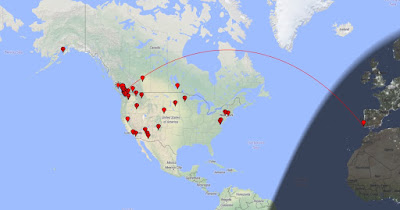 |
| courtesy: PSK Reporter |
I’m still somewhat ambivalent about FT8 and its ‘coldness’ when it comes to person-to-person interaction, but since most of the DX action on 6m is now digital, it’s either embrace it or miss out. At the moment, I’m at least prepared to hug it and see how it behaves. If it puts more Europeans and new DXCCs into my magic band log, then that’s a worthwhile investment.
Unlike way too many others, I’m not prepared to let my computer endlessly CQ for hours at a time. In a crowded local environment, with big strong signals being the norm, this method of operating is simply disrespectful to other amateurs as this mostly useless CQing will usually make reception of any weaker signals impossible.
FT8 is a weak-signal mode and the interfaces used do not handle extremely strong local signals very well. I would urge others to think about this poor operating practice and adopt what has always proved to be the best tactic for catching DX ... listen, listen, listen. The same tactic works just as well on FT8 as it does on CW.
Back to stacking firewood but having tossed me a bone yesterday, I’m sure the prop gods will be out to get even for awhile!
 The Enigmatic Heathkit CR-1 Crystal Radio
The Enigmatic Heathkit CR-1 Crystal Radio
For the past several months my interest in ‘DX-crystal radio’ construction has been percolating once again. It began when I ran across an interesting description of Heathkit’s legendary CR-1, a double-tuned good performer and very much sought-after by collectors as well as by users. The article described one homebrewer’s attempt to duplicate the receiver and to learn more about the detector and antenna tuning ferrite-loaded coil's secrets.

When it comes to crystal radios, there is nothing revolutionary regarding the CR-1’s basic circuitry but for some odd reason, it has achieved cult-like status as well as high dollar value.
I've been eager to get my mitts on one to see how it performs after reading of one DXer's fifty-eighth catch with his own CR-1!
The article that piqued my interest appears on 'Scott's Crystal Radios' website and makes for an inspirational read, eventually revealing the inside core arrangement of the ferrite-loaded tuned circuits via an actual X-ray of the device! By the way, if you are looking for a nice set of older headphones, Scott's website is the place to visit!
Scott was eventually able to achieve performance equal to that of his borrowed CR-1, with his own slightly modified versions, all in a similar-sized footprint. Perhaps this is one reason why the CR-1 is so much sought-after, as good performance in a very small package is not the norm when it comes to crystal radios. It's usually a case of ‘the bigger, the better’ when it comes to performance.
A recent search of my junque box revealed several NIB ferrite loopsticks that would allow a potntial reproduction of this interesting circuit.
Several years ago I spent an eye-opening winter learning about DX crystal radios as up to that time I had always believed it would be impossible to hear anything other than strong local signals on a crystal radio. I quickly discovered that there was a very large Crystal Radio Yahoo Group where menbers were working at the leading edge of crystal radio design. I also found that the group sponsored an annual Crystal Radio DX Contest which inspired me to dig deeper.
It wasn’t too long before I decided to join the fun and attempt to build a crystal radio DX-machine but I was in for a few surprises and a long learning curve ... it seemed that hearing broadcast band ‘DX’ on a crystal radio (anything other than loud locals) was not going to be an easy task!
Over the course of several months I tried many types of variable capacitors, tank coil configurations and antenna tuning circuits. I even erected a dedicated antenna system for the various experimental circuits I was putting together ... an 'Inverted-L', 50’ straight up and 70’ horizontal, along with a ground rod connected to several buried radials.
I quickly learned about something I normally didn’t have to worry about when working with ‘active’ devices and that was overcoming system and component losses. In critical crystal radio design, it’s all about minimizing the losses in every stage and every component in the system since there are no amplifiers to help overcome these losses. Your system is only as good as the weakest link. In true crystal radio DXing, no active devices are permitted ... it’s just your crystal radio and the energy generated at some, hopefully far away, transmitter site!
After several months, I eventually ended up with a well-performing triple-tuned set that used lots of 'trapping' because of all of the very strong nearby signals here ... eight 50kW locals!
A description of the learning curve, with several do's and dont's to help new builders, can be found on my website here.
Back then, 80 stations were logged (from my location on Mayne Island in SW British Columbia) over the one-week Crystal Radio DX Contest.
CRYSTAL RADIO LOGBOOK
Old notes indicate that there were 14 stations at S9 or higher, requiring heavy trapping to hear anything close to their frequencies.

When it comes to crystal radios, there is nothing revolutionary regarding the CR-1’s basic circuitry but for some odd reason, it has achieved cult-like status as well as high dollar value.
 |
| courtesy: Scotts Crystal Radios |
The article that piqued my interest appears on 'Scott's Crystal Radios' website and makes for an inspirational read, eventually revealing the inside core arrangement of the ferrite-loaded tuned circuits via an actual X-ray of the device! By the way, if you are looking for a nice set of older headphones, Scott's website is the place to visit!
 |
| courtesy: Scott's Crystal Radios |
Scott was eventually able to achieve performance equal to that of his borrowed CR-1, with his own slightly modified versions, all in a similar-sized footprint. Perhaps this is one reason why the CR-1 is so much sought-after, as good performance in a very small package is not the norm when it comes to crystal radios. It's usually a case of ‘the bigger, the better’ when it comes to performance.
A recent search of my junque box revealed several NIB ferrite loopsticks that would allow a potntial reproduction of this interesting circuit.
Several years ago I spent an eye-opening winter learning about DX crystal radios as up to that time I had always believed it would be impossible to hear anything other than strong local signals on a crystal radio. I quickly discovered that there was a very large Crystal Radio Yahoo Group where menbers were working at the leading edge of crystal radio design. I also found that the group sponsored an annual Crystal Radio DX Contest which inspired me to dig deeper.
It wasn’t too long before I decided to join the fun and attempt to build a crystal radio DX-machine but I was in for a few surprises and a long learning curve ... it seemed that hearing broadcast band ‘DX’ on a crystal radio (anything other than loud locals) was not going to be an easy task!
Over the course of several months I tried many types of variable capacitors, tank coil configurations and antenna tuning circuits. I even erected a dedicated antenna system for the various experimental circuits I was putting together ... an 'Inverted-L', 50’ straight up and 70’ horizontal, along with a ground rod connected to several buried radials.
I quickly learned about something I normally didn’t have to worry about when working with ‘active’ devices and that was overcoming system and component losses. In critical crystal radio design, it’s all about minimizing the losses in every stage and every component in the system since there are no amplifiers to help overcome these losses. Your system is only as good as the weakest link. In true crystal radio DXing, no active devices are permitted ... it’s just your crystal radio and the energy generated at some, hopefully far away, transmitter site!
After several months, I eventually ended up with a well-performing triple-tuned set that used lots of 'trapping' because of all of the very strong nearby signals here ... eight 50kW locals!
A description of the learning curve, with several do's and dont's to help new builders, can be found on my website here.
Back then, 80 stations were logged (from my location on Mayne Island in SW British Columbia) over the one-week Crystal Radio DX Contest.
FRQ | STATION | LOCATION | POWER |
540 | CBK | WATROUS, SK | 50KW |
550 | KARI | BLAINE, WA | 2.5KW |
560 | KPQ | WENATCHEE, WA | 5KW |
570 | KVI | SEATTLE, WA | 5KW |
580 | KFXD | NAMPA, ID | 5KW |
580 | KTMT | ASHLAND, OR | 1KW |
600 | CKBD | VANCOUVER, BC | 10KW |
650 | CISL | VANCOUVER, BC | 10KW |
670 | KBOI | BOISE, ID | 50KW |
690 | CBU | VANCOUVER, BC | 50KW |
730 | CJNW | VANCOUVER, BC | 50KW |
750 | KXL | PORTLAND, OR | 20KW |
770 | CHQR | CALGARY, AB | 50KW |
780 | KKOH | RENO, NV | 50KW |
790 | KGMI | BELLINGHAM, WA | 1KW |
800 | CKOR | PENTICTON, BC | 500W |
800 | CHAB | MOOSEJAW, SK | 10KW |
810 | KGO | SAN FRANCISCO, CA | 50KW |
820 | KGNW | SEATTLE, WA | 5KW |
830 | CKKY | WAINRIGHT, AB | 3.5KW |
840 | KSWB | SEASIDE, OR | 500W |
840 | CKBX | 100 MILE HOUSE, BC | 500W |
850 | KOA | DENVER, CO | 50KW |
860 | KPAM | TROUTDALE, OR | 10KW |
870 | KFLD | PASCO, WA | 250W |
880 | KIXI | MERCER ISLAND, WA | 10KW |
880 | COOL | EDMONTON, AB | 50KW |
890 | CJDC | DAWSON CREEK, BC | 10KW |
900 | CKMO | VICTORIA, BC | 10KW |
910 | CKDQ | DRUMHELLER, AB | 50KW |
920 | KXLY | SPOKANE, WA | 5KW |
930 | KBAI | BELLINGHAM, WA | 500W |
940 | CJGX | YORKTON, SK | 50KW |
950 | KJR | SEATTLE, WA | 50KW |
960 | CFAC | CALGARY, AB | 50KW |
980 | CKNW | NEW WESTMINSTER, BC | 50KW |
1010 | CBR | CALGARY, AB | 50KW |
1040 | CKST | VANCOUVER, BC | 50KW |
1060 | CKMX | CALGARY, AB | 50KW |
1070 | CFAX | VICTORIA, BC | 10KW |
1090 | KYCW | SEATTLE, WA | 50KW |
1130 | CKWX | VANCOUVER, BC | 50KW |
1160 | KSL | SALT LAKE CITY, UT | 50KW |
1170 | KPUG | BELLINGHAM, WA | 5KW |
1180 | KOFI | KALISPELL, MT | 10KW |
1190 | KEX | PORTLAND, OR | 50KW |
1200 | WOAI | SAN ANTONIO, TX | 50KW |
1210 | KBSG | AUBURN, WA, | 10KW |
1210 | KZTS | SUNNYSIDE, WA | 1KW |
1240 | KGY | OLYMPIA, WA | 1KW |
1240 | KOFE | ST. MARIES, ID | 500W |
1250 | KKDZ | SEATTLE, WA | 5KW |
1250 | KWSU | PULLMAN, WA | 5KW |
1260 | CFRN | EDMONTON, AB | 50KW |
1260 | KLYC | McMINVILLE, OR | 850W |
1270 | CHAT | MEDICINE HAT, AB | 10KW |
1270 | KTFI | TWIN FALLS, ID | 1KW |
1280 | KIT | YAKIMA, WA | 1KW |
1290 | KGVO | MISSOULA, MT | 5KW |
1290 | KUMA | PENDLETON, OR | 5KW |
1290 | KKSL | LAKE OSWEGO, OR | 5KW |
1300 | KOL | SEATTLE, WA | 5KW |
1300 | CJME | REGINA, SK | 10KW |
1310 | CHLW | ST. PAUL, AB | 10KW |
1320 | CHMB | VANCOUVER, BC | 50KW |
1340 | KLKI | ANACORTES, WA | 1KW |
1360 | KKMO | TACOMA, WA | 5KW |
1370 | KAST | ASTORIA, OR | 1KW |
1410 | CFUN | VANCOUVER, BC | 50KW |
1470 | CJVB | VANCOUVER, BC | 50KW |
1510 | KGA | SPOKANE, WA | 50KW |
1520 | KKSN | OREGON CITY, OR | 15KW |
1530 | KFBK | SACRAMENTO, CA | 50KW |
1550 | KCCF | FERNDALE, WA | 10KW |
1590 | KLIV | SAN JOSE, CA | 5KW |
1600 | KVRI | BLAINE, WA | 10KW |
1620 | KYIZ | RENTON, WA | 1KW |
1640 | KPBC | LAKE OSWEGO, OR | 1KW |
1660 | KXOL | BRIGHAM CITY, UT | 1KW |
Old notes indicate that there were 14 stations at S9 or higher, requiring heavy trapping to hear anything close to their frequencies.
| My recent interest made me wonder what the situation is today when it comes to the number of strong local ‘blowtorch’ signals, surely the bane of all crystal radio DXers? Although there have been a few changes over the years, a quick scan of the band during the prime DX evening hours found that although one of the blowtorch signals (at 600kHz) was now gone, another had appeared at 1200kHz ... sadly no net difference. The top end of the band, always a prime area for good skywave DX, is unfortunately still dominated by a huge signal from KVRI just across the water near the Canadian / U.S. border. If KVRI were silent, the top end would be a wonderfully quiet hunting-ground for new catches. The new local blowtorch (CJRJ) on 1200 kHz will now cause problems for the middle of the band, which was always a good region for DX. So it seems overall, there hasn’t been a huge change here other than in the middle of the band. It looks as though there are still some good watering-holes to be had but several traps will still be needed in any new system. Once my present radio-bench project is finished (a '36 RK-39 crystal power oscillator) I’m looking forward to more research and design of a couple of new systems, starting with something similar to the CR-1 as well as some experimentation with toroidal coils. I always find the research and planning phase of any new project more interesting and fulfilling than the actual construction and implementation! Hopefully I’ll have something ready for the fall DX season! Thanks to VA7MM, I will also have the loan of an original CR-1 next winter to make comparisons to any clone that I might build! If building a DX-crystal radio is something that might interest you, there are several great websites offering inspiration and helpful info. The links for these may be found at the bottom of my own crystal radio page. As well, there are two active crystal radio groups on Facebook, where daily two-way discussion can be had. Perhaps, with enough new interest, we can even revive the annual Crystal Radio DX Contest! |

